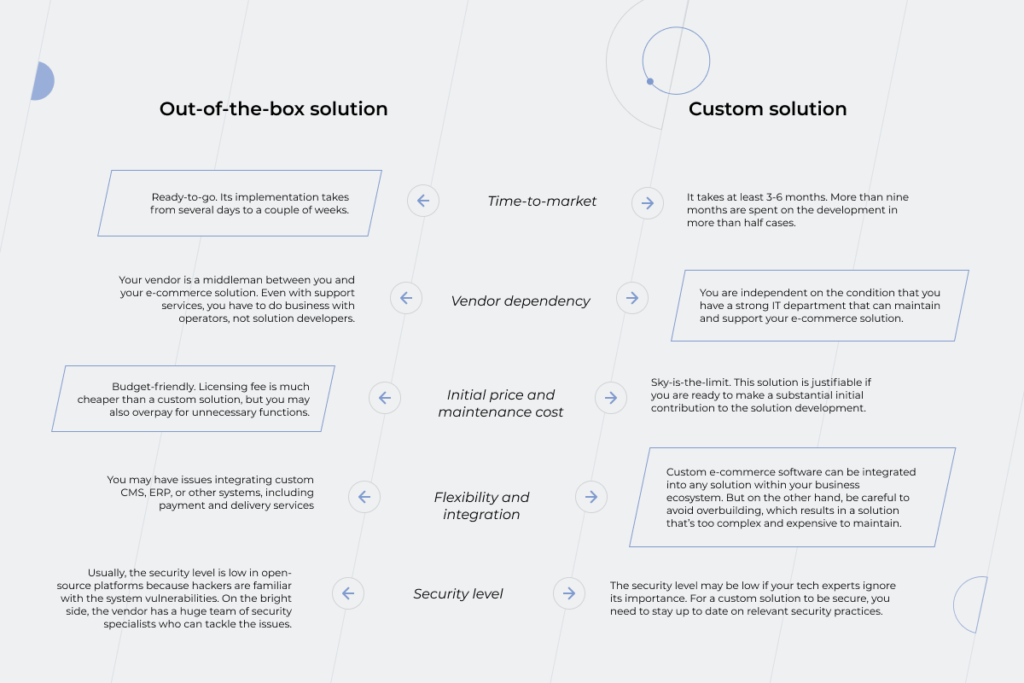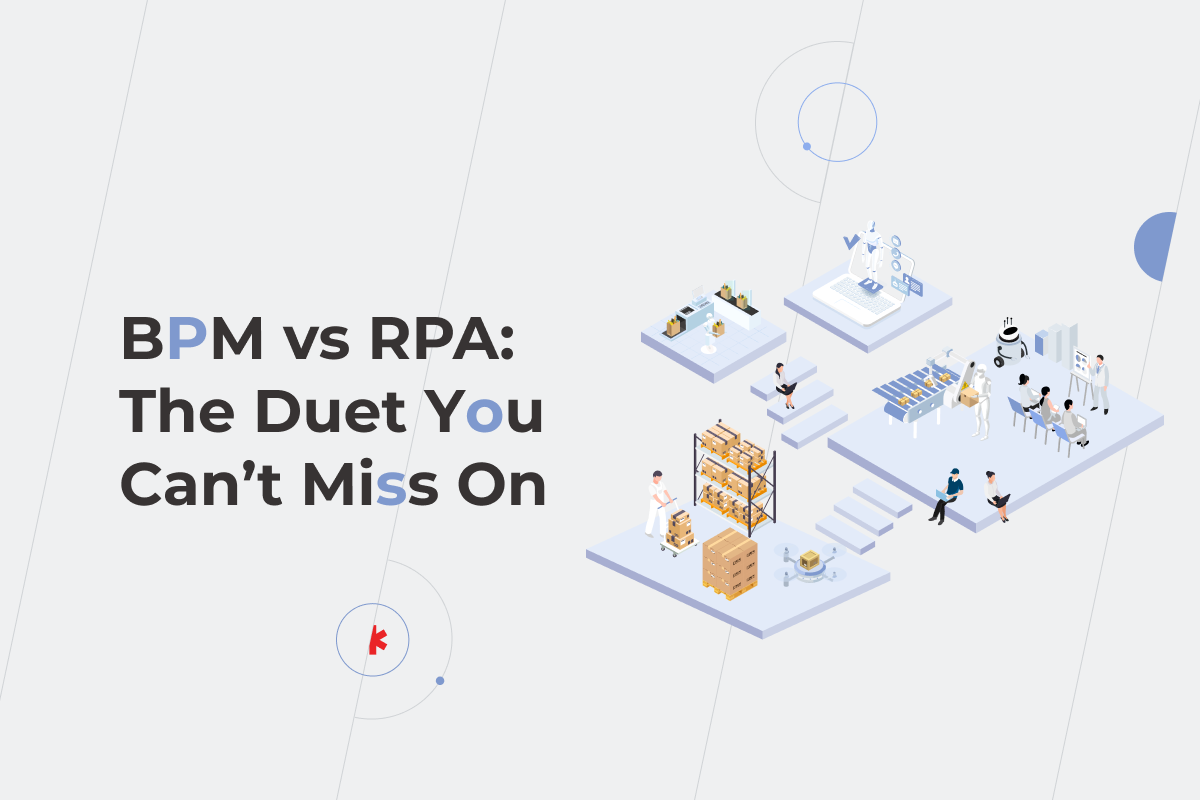Contents
As people were trapped indoors under COVID-19 lockdowns, the global monthly number of visits to retail websites rose from 16 billion in January 2020 to 22 billion in June 2020, and there’s no way back — shopping has entered a new era. We let our introvert genies out of the lamps during the pandemic. Although we still miss traveling or spontaneous get-togethers with friends in a bar, shopping has become a part of life that can be left to technology without regret. No wonder there are businesses that have managed to thrive in this environment. For example, Walmart invested in e-commerce to provide their customers with online grocery delivery and pickup, and in the second quarter of 2020 company’s sales were 97% up. So the question of whether or not to go online isn’t really a question anymore. What you really should think about is how you’re going to get there.
Implementing an e-commerce solution is one of the ways to meet your customers’ expectations. There are two options to choose from — custom or out-of-the-box software. What are the benefits and drawbacks of each? Is there an alternative that marries the advantages of these options? We’ll help you solve the build-or-buy dilemma and decide on the most suitable and profitable e-commerce solution for your business.
The key to finding the right answers is asking the right questions
Every business owner who decides to implement e-commerce software wants to get the best thing since sliced bread. But what solution should be considered as the best? Quick? Efficient? Secure? Certainly, but the answer will also depend on the type of your business, the functions you need, and so much more. Our experts have prepared a list of questions you should ask yourself when choosing an e-commerce system and provided unbiased advice according to your responses.
Do you have a solid business plan? How much could your business change or grow in the nearest future?
An out-of-the-box solution is a good way to test how beneficial e-commerce is if you’re only starting your business on the web. Figure out whether your customers are comfortable with ordering online and satisfied with the functionality that an out-of-the-box application offers. You don’t have to invest a fortune to find out how e-commerce software implementation will impact your business regarding the number of new customers and revenue increase.
A custom solution may not seem as appealing as a ready-made option, due to the high initial costs of software development. It’s also risky if you aren’t sure how your business will develop in the next one or two years. You can benefit from a bespoke e-commerce solution if you’ve already tried an out-of-the-box one and understood that it doesn’t match your organization’s structure and your back-office requirements. For instance, your teams are located across various countries, or each team is responsible for a particular production stage.
Do you need integrations with your in-house systems?
Out-of-the-box solutions allow integrations with widespread CRMs, ERPs, inventory management systems, etc. It’s critical as integration with an ERP system enables you to optimize your company on an operational level while CRM integration empowers your business to keep better track of customers and create personalized experiences for them to feel special.
However, according to *instinctools VP of Engineering, Alexey Astakhov, there’s a fly in the off-the-shelf software ointment:
Using custom-made CRM, ERP, or other business systems might be a dealbreaker for their integration with an out-of-the box e-commerce solution. Whether the system is closed source and all the issues have to be handled via the tech support, or it is open source and you are supposed to deal with the code written by someone else. Such an integration will take you a lot of time, effort, and money either way.
A custom solution is unlimitedly flexible regarding integrations as you can adjust it to any of your in-house systems.
Is time-to-market critical for you?
An out-of-the-box solution is easy and quick to implement. By going for it, you exclude research, development, and testing stages from the process and can enter the market within a few days or a couple of weeks max, depending on the number of goods to upload. This option looks especially attractive to startups that can’t wait to check whether their idea will take off.
A custom solution usually requires more time since you have to build it from scratch according to your particular business processes and unique requirements. 51% of respondents of the Unilog annual B2B digital commerce report claimed that custom e-commerce solution implementation took them more than nine months. Nevertheless, time-to-market fades into the background if you need a unique solution or an integration with a custom ERP, CRM, BI system without which you can’t run your business efficiently.
How important is it to create a unique design of the system?
Out-of-the-box solutions offer — surprise, surprise — run-of-the-mill design. It’ll work if your customers just need the product regardless of the UI your offering is wrapped in. Just make sure that the selected solution is good in terms of simplicity and usability. If your customers struggle to find the cart because of an incorrect or difficult-to-use layout, they won’t hesitate to switch to your competitors that give users the possibility to navigate through the online store without a hitch and make a purchase in one click.
A custom solution allows you to create software with unique UX/UI that would stand out from the crowd of similar stores and emphasize brand identity. This is critical, for instance, if you focus on the luxury segment. Targeted at a narrow audience, they can’t put their customers’ loyalty at risk with a sketchy design. So if your offer expands beyond just a product to a lifestyle, you might not find what your customers need among ready-made solutions.
Which payment and delivery solutions do you want to use?
Out-of-the-box solutions work for the territories with similar widespread delivery (FedEx, DPD, etc.) and payment services such as PayPal, Visa, Mastercard, etc.
A custom solution is your choice if you sell goods in countries with different payment and delivery services. For instance, payment via PayPal isn’t available in China and some Eastern European countries. If you don’t want to miss this market, you have to provide an alternative payment method for these regions and integrate it with your e-commerce software. The same works for shipping — there are countries where the delivery service offered within your ready-made solution isn’t available.
What marketing solutions need to be included in the system?
An out-of-the-box solution is a nice fit if you plan to use standard marketing activities such as running social media campaigns, giving discounts and coupons to your customers, sending them newsletters, creating promotions, etc. But even if your marketing solutions are more standardized, you have to consider your market. The success of your marketing effort depends on the possible compatibility of the ready-made e-commerce solution and, for instance, your social media. It means, if you sell products to Chinese customers, you should consider integrating your solution with WeChat, which is the most popular messaging app in China.
A custom solution is a better option if, in addition to the standard marketing activities, such as social media integrations, you use specific ones. For example, you may lack a journey builder that allows delivering personalized experiences at every step of the customer lifecycle. Then think of developing a custom solution or customizing a ready-made offer with the help of experienced developers.
Do you need a business intelligence solution to facilitate more informed decision-making?
An out-of-the-box solution can have built-in BI such as Magento BI that allows you to run RFM (Recency, Frequency, Monetary) analysis for customer segmentation. Also, popular ready-made software such as Magento and Shopify can be easily integrated with the most popular BI tools such as Power BI, Tableau, Qlik, providing real-time information about your customers, marketing, and sales processes.
A custom solution is more favorable if the BI system you plan to incorporate into your e-commerce software is tailor-made. If you need custom dashboards with specific metrics to track or bespoke data analytics features, they might not comply with ready-made software. It doesn’t mean though that you have to give up on an idea of a one-of-a-kind business intelligence solution. Instead, consider the implementation of a made-to-order e-commerce platform. Compare two approaches: you can just track how many customers abandoned their carts or take advantage of full-fledged BI services with good data visualization tools to uncover the reasons for high abandonment rates. For example, if you check where the customers who tend to abandon their carts come from, you may find out in which regions your shipping costs are too high and implement other delivery options.
Are you planning to offer special pricing for regular customers?
An out-of-the-box solution is limited in personalizing customers’ experience. But at least you can personalize blocks such as product recommendations according to the customer’s age or based on the products in the same category and price range.
A custom solution wins if you want to establish a category of regular customers and offer them special pricing and personal discounts or provide customers with extra services such as tracking the order and viewing a report of all their orders during a given period. Take this into account because 80% of consumers are more likely to buy from a company that treats them as individuals with their own needs.
How much support do you expect from the development partner?
An out-of-the-box solution implies that you discuss a problem with call-center operators, not software developers. Besides, you depend on the speed of your vendor’s business processes, so tasks such as testing SEO-related aspects, website functionality for various user scenarios, security, performance under high loads, integrating an e-commerce solution with other company’s systems, and things like that may take more time because your request gets in a long line of similar requests from other companies that the vendor serves.
A custom solution entails direct communication with the development team as part of your vendor’s maintenance and support services. If you intend to put the responsibility for the system maintenance and support on your in-house IT department, make sure that the vendor’s developers have transferred the knowledge to your staff and your employees have enough expertise to get the job done well.
What does it all leave you with? If you still can’t wrap your mind around which option to go for, take a look at the comparative table that summarizes the benefits and drawbacks of ready-made and bespoke software.

A customized out-of-the-box solution: progressing from what it is to what it could be
You can combine a vendor-supplied solution with customization to make most of both options. Customized e-commerce solutions are popular as they allow you to finetune out-of-the-box software while staying on budget. But don’t confuse minor adjustments that you can make by yourself with real customization that requires professional support. Take Shopify as an example. You may not be satisfied with just changing a theme, which is limited to adding or removing different marketing and conversion blocks such as quick view, recommended products, product reviews, newsletter signup, etc. If you want to make some changes on the back-end side, hire experienced B2B ecommerce developers who will enhance a ready-made solution with a custom zest in terms of:
- Design. Instead of relying on a standard theme, you can change the site’s visuals.
- Functionality. Enrich your out-of-the-box solution with custom-built features such as personalized offerings.
- Integration development. Implement trusted third-party plugins to enter new markets. For instance, you can integrate different shipping options to cover more regions.
- Extension development. Create specific functionality extensions, for example, implement personalized loyalty campaigns.
Figuring out the right way to a full-fledged e-business
Don’t let bright and inspiring statistics about e-commerce efficiency blind you. Any solution alone won’t put your business on the fast track to success. First, answer the questions we’ve listed above. Depending on the answers, you may lean towards out-of-the-box or custom software. If, for some reason, you need an e-commerce solution ‘right here right now,’ you’d better choose an out-of-the-box one. But if you are not ready to trade your unique requirements for swift implementation, a custom option will be the better fit.
Are you still undecided whether to choose out-of-the-box software or a custom solution? Or you have made up your mind but don’t know where to start? In all cases, you can reach out to our software development experts to discuss the pros and cons of each e-commerce solution regarding your business’s needs.










